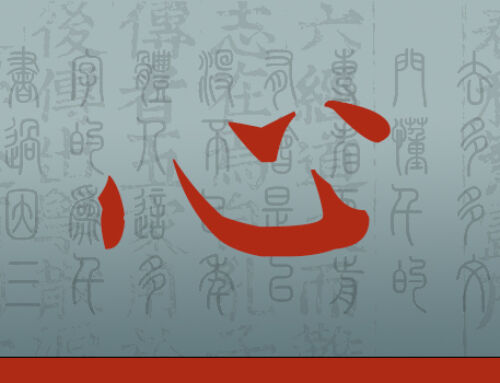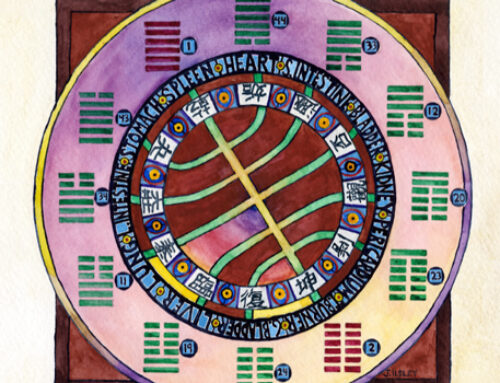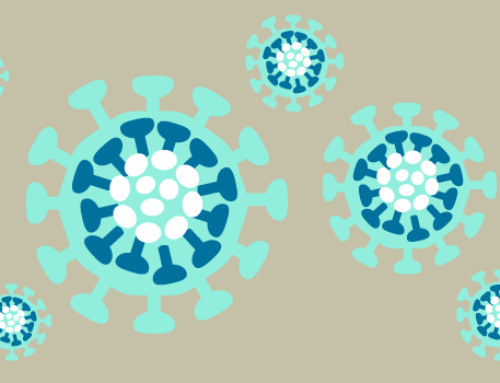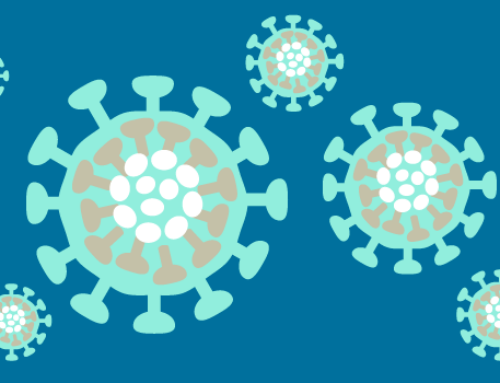By Heiner Fruehauf
National University of Natural Medicine, College of Classical Chinese Medicine
Historic records indicate that the Chinese have used alcohol in medicine since the invention of alcohol itself, an event that occurred approximately 4000 year ago during the recently archeologically verified Xia Dynasty. The intricate relationship between alcohol and the healing arts has even been incorporated in the emblem of the Chinese medical profession: The term YI (medicine, doctor), initially coined to distinguish “scientific” healers from shamanist quacks, prominently features the pictogram “Wine.”
The earliest alcohol remedies in China were produced by including specific herbs such as Curcuma in the fermenting process of the traditional, low proof Asian rice wine. The nowadays common procedure of steeping herbs in strong white liquor was introduced around 500 A.D. The method of concocting herbs in wine or liquor was also introduced later and was widely used only during Chinas last dynasty, the Qing.
Herbal remedies including alcohol as a catalyst are included in all major Chinese works on herbal prescriptions, including the Neijing, the Shanghan lun, the Qianjin fang, and other classics. It is important to note, however, that the overall percentage of alcohol formulas is only about 1% of the entire amount of prescriptions listed in the respective works. Synthesizing the bulk of alcohol formulas introduced over the last 2,200 years, it appears that alcohol based formulas are reserved for a distinct and very limited range of diseases.
The Ershiwu bingfang, the earliest record of TCM formulas found in a pre-Qin (prior to 221 B.C.) gentry grave, lists 30 alcohol prescriptions, mostly recommended for snake bites and skin diseases.
The Neijing, synthesizing Taoist healing systems before the Han dynasty into the definitive theoretical foundation of Chinese medicine, mentions wine remedies in a chapter heading. Dispersed throughout the entire book, several medicinal wines for the treatment of “meridian blockage,” sudden fainting, and tympanites are introduced.
The Han biography of the legendary acupuncturist Bian Que records two memorable healings involving alcohol: Once he rescued King Jizhao from a heart attack by prescribing Three Mineral Wine, and another time he saved the life of King Miaochuan’s favorite concubine with a birth inducing alcohol mixture.
Zhang Zhongjing’s formula classics, Shanghan lun and Jingui yaolüe, introduce Honglanhua jiu (Carthamus Wine) for gynecolocical disorders involving stagnating blood, and Gualou xiebai baijiu tang (Trichosanthes, Bakeri, and Rice Wine Combination, mistakenly translated as Trichosanthes, Bakeri, and Vinegar Combination by Hong Yen-hsu) for heart disease. Both of these 1850 year old formulas are still widely used today.
Since Zhang Zhongjing’s work defined the standards of Chinese formula composition for centuries to come, it is especially important to consider his use of wine in order to define the traditional applications of alcohol prescriptions. Zhang’s formulas are classic not only because of the precise positioning of each herb within the formula, but also because of the author’s exacting reflection on how and when to prescribe a particular formula instead of just listing what ingredients it is composed of. His selective, yet highly effective use of alcohol formulas tells us two things: a) Zhang looked at alcohol as an adjunct herb, the properties of which had been defined in the chapter on food in the historical encyclopedia of the Han: wine is hot, reaches every part of the body, harmonizes bloood and qi, opens the meridians, fosters yang and expells cold. b) Zhang used alcohol remedies exclusively if warming and blood vitalizing effect was desired.
Beginning late in the 6th century, the Tang and Song dynasties saw the usage of alcohol formulas extended to a much wider range of diseases, but the warming and blood vitalizing concept guideline still persisted. Sun Simiao mentions 80 alcohol formulas throughout his two classic compendia, Thousand Ducat Formulas and Supplement to the Thousand Ducat Formulas (Qianjin yaofang, Qianjin yifang), and the host of Song dynasty compilations (Heji jufang, Taiping shenghui fang, Jisheng fang, Sanyin fang) list several hundreds, including prescriptions for pediatric patients.
The Song work, Comprehensive Recording of Sage-like Aids from the Zhenghe Era (Shengji zonglu, 1122) includes a rare theoretical introduction about the general application of alcohol formulas, pointing out that due to the penetrating action of alcohol, wine formulas are superior to concoctions in heavy duty cases of meridian obstruction. Furthermore, the text particularly recommends alcohol formulas for the following symptom complexes: a) blood deficiency and qi stagnation, b) cold syndrome, c) paralysis d) cramping and sudden fainting, thus reaffirming the ancient definition of alcohol formulas as either a emergency remedy or a meridian opener.
During the same time period, doctors began heating the alcohol in order to extract more medicinal components from the herbs steeped inside. The Song also saw the publication of books (Yanglao juqin shu, Yinshan zhengyao) that specifically recommend the consumption of small quantities of medicinal wines as part of a preventive regimen for the elderly.
Since the 14th century (during the Ming and the Qing dynasties), the practice of taking tonic wines became more and more prevalent in palace circles and among the affluent elite. The Ming compendium Puji fang, with 50,000 listings the largest formula compendium ever compiled in China, records 300 alcohol based prescriptions.
As part of a general drive to standardize traditional Chinese medical knowledge, PRC researchers have recently attempted to reevaluate the usage of alcohol formulas. A large scale clinical study with 222 arthritis and rheumatoid arthritis patients showed satisfying results, and another study involving 37 patients with high blood fat levels was also thought of as promising. Two recently published books on alcohol formulas (A Great Compendium of Chinese Medicinal Wines, 1991; Treating 100 Diseases with Medicinal Wines, 1990) list various forms of alcohol prescriptions for almost every major disease, but the editors point out that a lot of these formulas were often derived from singular, unorthodox sources: “Many of these formulas, of course, may reflect the experience of one doctor only. It still remains rather unclear whether or not we can really use them on a wide basis.” Most formulas, clearly, fall into the traditional categories of blood vitalizing, warming, and meridian openers. The diseases most frequently mentioned are:
1) Internal medicine
a. arthritis, rheumatoid arthritis
b. paralysis (apoplexy)
c. impotence
d. cough/asthma
2) Gynecology
a. amenorrhea
b. dysmenorrhea
c. infertility
d. stagnating blood
e. post-partum disorders
3) Pediatrics
a. Goulou bing (growth disorders due to malnutrition)
b. epilepsy
4) External medicine
a. obliterating phlebitis, arteritis
5) Dermatology
a. eczema
b. neurodermatitis
c. psoriasis
d. leprosis
6) Orthopedics
a. injuries
b. fractures
7) Others
a. tooth ache
b. tinnitis
c. loss of voice
Alcohol has the marked advantage that it preserves the often very precious herbs, something that might have been an important factor in ancient China. Due to its own medicinal properties, however, the use of alcohol based formulas is clearly limited to a rather narrow range of symptoms and constitutions. Also, patients with high blood pressure, liver disease, certain types of heart disease, and alcohol allergy should not take alcohol formulas, no matter what their symptoms are. Alcohol easily reacts with modern Western drugs such as diuretics, anti-depressants, and certain types of hypertensive medication.
It is important to note in this context that alcohol formulas as they appear in the Chinese literature are not tinctures, but require the administration of a fairly large amount of alcohol. Sun Simiao warned doctors and patients about the side effects of alcohol if consumed in excessive quantities, but he also mentioned that it was absolutely essential to drink as much of the respective potion until the effect of the alcohol could be felt. Modern Chinese medical books point out that it can be considered safe for a 130 pound person to consume 100g of 60% white liquor daily. The practice of manufacturing herbal tinctures from fresh plants is only utilized for laboratory research in China.
In urban China where the standard of living is rising considerably and the market for “longevity” potions is booming, medicinal wines are known to cause problems since patients often buy the “healthful” factory products without consulting with a physician about their constitution or a particular problem first.
Alcohol formulas, in sum, should be considered limited to certain areas of treatment. An interesting question which modern researchers have not been able to answer yet is whether some herbs—particularly certain vines found in folk herbals—that seem to be exclusively used in alcohol formulas, can manifest their healing properties only in combination with alcohol (as many Taoist folk healers claim).
© 2006 Heiner Fruehauf









[…] aggiunge che la pratica dell’infusione Erbe cinesi sotto spirito per scopi medicinali non è nuovo. “È stato documentato circa 2.000 anni fa nel primo libro sulla medicina […]
[…] aggiunge che la pratica dell’infusione Erbe cinesi sotto spirito per scopi medicinali non è nuovo. “È stato documentato circa 2.000 anni fa nel primo libro sulla medicina […]
[…] dodaje, że praktyka zaparzania Zioła chińskie w alkoholu do celów leczniczych nie jest nowy. „Zostało to udokumentowane około 2000 lat temu w pierwszej książce o […]
[…] adds that the practice of infusing Chinese herbs in alcohol for medicinal purposes is not new. “It was documented around 2,000 years ago in the first book on Traditional Chinese […]
[…] adds that the practice of infusing Chinese herbs in alcohol for medicinal purposes is not new. “It was documented around 2,000 years ago in the first book on Traditional Chinese […]
[…] agrega que la práctica de infundir Hierbas chinas en alcohol con fines medicinales no es nuevo “Se documentó hace unos 2.000 años en el primer libro de Medicina Tradicional China […]
[…] ajoute que la pratique consistant à infuser Herbes chinoises dans l’alcool à des fins médicinales n’est pas nouveau. « Il a été documenté il y a environ 2 000 ans dans le premier livre […]
[…] adds that the practice of infusing Chinese herbs in alcohol for medicinal purposes is not new. “It was documented around 2,000 years ago in the first book on Traditional Chinese […]